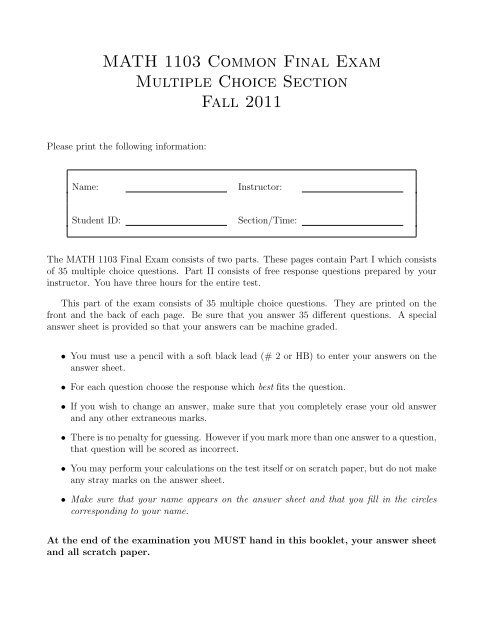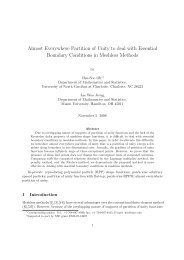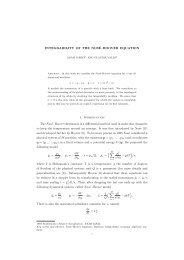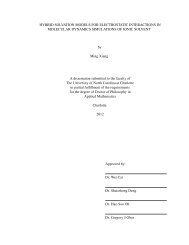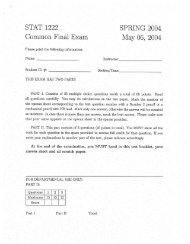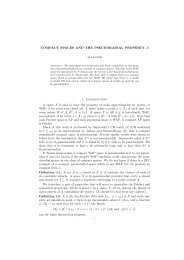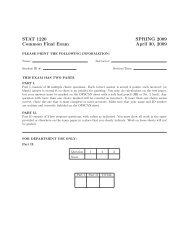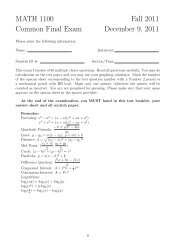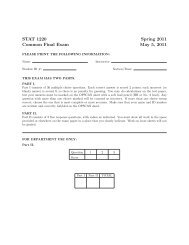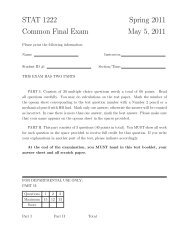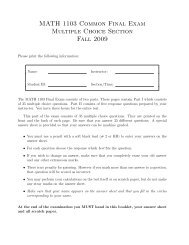MATH 1103 Common Final Exam Multiple Choice Section Fall 2011
MATH 1103 Common Final Exam Multiple Choice Section Fall 2011
MATH 1103 Common Final Exam Multiple Choice Section Fall 2011
You also want an ePaper? Increase the reach of your titles
YUMPU automatically turns print PDFs into web optimized ePapers that Google loves.
<strong>MATH</strong> <strong>1103</strong> <strong>Common</strong> <strong>Final</strong> <strong>Exam</strong><br />
<strong>Multiple</strong> <strong>Choice</strong> <strong>Section</strong><br />
<strong>Fall</strong> <strong>2011</strong><br />
Please print the following information:<br />
Name: Instructor:<br />
Student ID: <strong>Section</strong>/Time:<br />
The <strong>MATH</strong> <strong>1103</strong> <strong>Final</strong> <strong>Exam</strong> consists of two parts. These pages contain Part I which consists<br />
of 35 multiple choice questions. Part II consists of free response questions prepared by your<br />
instructor. You have three hours for the entire test.<br />
This part of the exam consists of 35 multiple choice questions. They are printed on the<br />
front and the back of each page. Be sure that you answer 35 different questions. A special<br />
answer sheet is provided so that your answers can be machine graded.<br />
• You must use a pencil with a soft black lead (# 2 or HB) to enter your answers on the<br />
answer sheet.<br />
• For each question choose the response which best fits the question.<br />
• If you wish to change an answer, make sure that you completely erase your old answer<br />
and any other extraneous marks.<br />
• There is no penalty for guessing. However if you mark more than one answer to a question,<br />
that question will be scored as incorrect.<br />
• You may perform your calculations on the test itself or on scratch paper, but do not make<br />
any stray marks on the answer sheet.<br />
• Make sure that your name appears on the answer sheet and that you fill in the circles<br />
corresponding to your name.<br />
At the end of the examination you MUST hand in this booklet, your answer sheet<br />
and all scratch paper.
<strong>MATH</strong> <strong>1103</strong> <strong>Final</strong> <strong>Exam</strong> <strong>Multiple</strong> <strong>Choice</strong><br />
1. A bank loaned out $100, 000, part of it at the flat rate of 10% per year and the rest at<br />
the flat rate 6% per year. If, after one year, the total interest received on both loans was<br />
$7, 600, how much was loaned at 10%? (Simple interest is paid once, at the end of the<br />
year.)<br />
(a) 20, 000 (b) 30, 000 (c) 40, 000 (d) 50, 000 (e) 60, 000<br />
2. Find the domain of the function f(x) =<br />
1 1<br />
√ − √ .<br />
20 − 2x x − 5<br />
(a) [5, 10) (b) (5, 10) (c) [5, 20) (d) (5, 22) (e) (−∞, ∞)<br />
3. Which of the following lines is perpendicular to the line given by 2x + 3y = 5?<br />
(a) y = − 2<br />
3<br />
x − 1 (b) y = 2<br />
3<br />
x − 2 (c) y = −3<br />
2<br />
3<br />
5<br />
x − 3 (d) y = x − 4 (e) x =<br />
2 2<br />
4. Find the average rate of change for the function f(x) = |x − 1| between x = −1 and<br />
x = 1.<br />
(a) 1 (b) 1<br />
2<br />
(c) 0 (d) − 1<br />
2<br />
(e) −1<br />
5. Consider the piecewise defined function<br />
⎧<br />
Evaluate f(0) + f(1).<br />
(a) undefined (b) 0 (c) 1<br />
2<br />
⎪⎨<br />
f(x) =<br />
⎪⎩<br />
− 1<br />
x<br />
1<br />
x + 1<br />
(d) 1 (e) 3<br />
2<br />
if x < 0,<br />
if x ≥ 0.<br />
6. If you translate the graph of y = f(x) down 3 units and then apply a vertical compression<br />
by a factor of 2<br />
, you get the graph of<br />
3<br />
(a) y = 3<br />
2<br />
(d) y = 2<br />
3<br />
f(x) − 3 (b) y = 2<br />
3<br />
2<br />
f(x) − 3 (e) y = f(x) − 2<br />
3<br />
2<br />
f(x) + 3 (c) y = f(x) + 2<br />
3<br />
<strong>Fall</strong> <strong>2011</strong> 1
<strong>MATH</strong> <strong>1103</strong> <strong>Final</strong> <strong>Exam</strong> <strong>Multiple</strong> <strong>Choice</strong><br />
7. Match the function to the graph shown below:<br />
(a) f(x) = (x − 2) 2 + 4<br />
(b) f(x) = −(x − 2) 2 + 4<br />
(c) f(x) = (x + 2) 2 + 4<br />
(d) f(x) = −(x + 2) 2 + 4<br />
(e) f(x) = −(x − 2) 2 − 4<br />
8. The function f(x) = x/(x 2 − 1) is<br />
(−2, 4)<br />
(a) even (b) odd (c) not defined at x = 0 (d) neither even, nor odd<br />
(e) not a function (fails the vertical line test)<br />
9. Find the inverse of f(x) = 2x 3 + 1.<br />
3 x − 1<br />
3√<br />
x − 1<br />
(a)<br />
(b) (c)<br />
2<br />
2<br />
3<br />
<br />
x + 1<br />
2<br />
10. Solve the inequality x 2 − 2x + 1 > 4.<br />
(d) 3<br />
<br />
x − 1<br />
2<br />
(e)<br />
3√ x − 1<br />
(a) x < −1 (b) x > 2 (c) −2 < x < 2 (d) −1 < x < 3 (e) x < −1 or 3 < x<br />
11. Find the composite function f ◦ g(x) = f(g(x)), given f(x) = 1<br />
and g(x) =<br />
x + 1 1<br />
3x + 1<br />
(a)<br />
3x + 2<br />
3x + 1<br />
(b)<br />
3x − 2<br />
3x − 1<br />
(c)<br />
3x<br />
x + 1<br />
(d)<br />
2 − x<br />
(e) 1<br />
3x<br />
12. Consider the function f(x) = x 2 on the interval [0, ∞). What is f −1 (2)?<br />
(a) − √ 2 (b) 0 (c) √ 2 (d) − √ 2 or √ 2 (e) Not defined, f is not one to one.<br />
2<br />
3x − 1 .<br />
<strong>Fall</strong> <strong>2011</strong> 2
<strong>MATH</strong> <strong>1103</strong> <strong>Final</strong> <strong>Exam</strong> <strong>Multiple</strong> <strong>Choice</strong><br />
13. Solve the equation 4 x − 18 · 2 x + 32 = 0. What is the difference of the two solutions?<br />
(a) 0 (b) 1 (c) 2 (d) 3 (e) 4<br />
14. Find the equation of the axis of symmetry of the parabola f(x) = 3x 2 + 30x − 11.<br />
(a) x = −11 (b) x = −10 (c) x = −5 (d) x = 5 (e) x = 10<br />
15. What is the largest rectangular area a farmer can enclose using 600 yards of fencing<br />
material?<br />
(a) 22, 000 square feet (b) 22, 500 square feet (c) 36, 000 square feet (d) 40, 000<br />
square feet (e) 90, 000 square feet<br />
16. Using the rational zeros theorem, list all potential rational zeros of the equation x 2 −3 = 0.<br />
Do not solve the equation!<br />
(a) x = ± √ 3 (b) x = ±3 (c) x = ±1 (d) x = ±1, ±3 (e) No potential rational<br />
solution.<br />
17. What remainder do you get when you divide x 100 + x − 2 100 by (x − 2)?<br />
(a) 0 (b) 1 (c) 2 (d) 3 (e) 2 100<br />
18. For what numbers of x in the interval [−2π, 2π] does the graph of y = csc x have a vertical<br />
asymptote? (Angles are measured in radians.)<br />
(a) −2, −1, 0, 1, 2 (b) − 3π π 3π<br />
, −π , ,<br />
2 2 2 2<br />
(e) No vertical asymptote.<br />
(c) −2π, π, 0, π, 2π (d) −2π, 0, 2π<br />
19. List all values of x that must be excluded from the domain of the rational function<br />
x(x − 1)<br />
f(x) =<br />
(x + 2)(x + 3) .<br />
(a) x = 0, 1, −2, −3 (b) x = 0, −1, 2, 3 (c) x = −2, −3 (d) x = 2, 3 (e) x = 0, 1<br />
<strong>Fall</strong> <strong>2011</strong> 3
<strong>MATH</strong> <strong>1103</strong> <strong>Final</strong> <strong>Exam</strong> <strong>Multiple</strong> <strong>Choice</strong><br />
x − 2<br />
20. Find all asymptotes (horizontal and vertical) of f(x) =<br />
x2 − 4 .<br />
(a) x = −2 only (b) x = 2 and x = −2 (c) x = 2, x = −2 and y = 0<br />
(d) x = −2 and y = 0 (e) x = 2 and y = 1<br />
1<br />
21. Solve the inequality ≥ 1.<br />
x + 1<br />
(a) (−1, 0] (b) [−1, 0] (c) (−∞, −1]∪[0, ∞) (d) (−∞, −1)∪[0, ∞) (e) (−∞, −1)∪<br />
(−1, ∞)<br />
22. Find the domain of f(x) = ln(x − 1).<br />
(a) all real numbers (b) x < 1 (c) x ≤ 1 (d) x > 1 (e) x ≥ 1<br />
23. Use the base-change formula to find log 2(7). Round your answer to the nearest decimal<br />
digit.<br />
(a) 2.5 (b) 2.6 (c) 2.7 (d) 2.8 (e) 2.9<br />
24. Convert the equation 4−2 = 1<br />
to logarithmic form.<br />
16<br />
(a) log−2 (4) = 1<br />
16<br />
<br />
1<br />
(b) log−2 = 4 16 (c) log4(−2) = 1<br />
(4) = −2<br />
16<br />
(e) log 1<br />
16<br />
25. Write ln(x) + 2 ln(y) − 2 ln(z) as a single logarithm.<br />
3<br />
3 x<br />
(a) ln<br />
√ 2y<br />
z2 <br />
x<br />
(b) ln<br />
y3 z2 <br />
x<br />
(c) ln<br />
3 y2 z2 <br />
26. Solve the equation 3 3x+1 = 9 x .<br />
(a) x = −2 (b) x = −1 (c) x = 0 (d) x = 1 (e) x = 2<br />
(d) log 4<br />
<br />
1 = −2<br />
16<br />
(d) ln(x 3 y2z 2 <br />
2xy/3<br />
) (e) ln<br />
2z<br />
27. Find the amount in 20 years if a principal P = 5, 000 is invested at the nominal rate of<br />
r = 5%, compounded quarterly. Round your answer to the nearest dollar.<br />
(a) 13, 590 (b) 13, 563 (c) 13, 507 (d) 13, 480 (e) 13, 425<br />
<strong>Fall</strong> <strong>2011</strong> 4
<strong>MATH</strong> <strong>1103</strong> <strong>Final</strong> <strong>Exam</strong> <strong>Multiple</strong> <strong>Choice</strong><br />
28. A new flu virus starts spreading across a town whose population is 300, 000 people. The<br />
number of people infected is f(t) = 5 · e 0.3t where t is measured in days. If no measures<br />
are taken, after how many days will everybody be infected in the town?<br />
(a) 22 days (b) 27 days (c) 32 days (d) 37 days (e) 42 days<br />
29. The wheel of a truck has 18 inch diameter. How much does the wheel turn while the<br />
truck travels 3 inches? Express your answer in radians.<br />
(a) 1/6 (b) 1/4 (c) 1/3 (d) 1/2 (e) 1<br />
30. Find the exact value of cos 2 (15 o ) − sin 2 (15 o ).<br />
(a) 0.5 (b)<br />
√ 3<br />
2<br />
18”<br />
?<br />
3”<br />
(c) 0.866 (d) −0.5 (e) 1<br />
√ 2<br />
<br />
π · x<br />
<br />
31. Determine the amplitude and period of f(x) = (−3) · sin . (Angles are measured<br />
6<br />
in radians.)<br />
(a) Amplitude: 3 Period: 12 (b) Amplitude: −3 Period: 12<br />
(c) Amplitude: 6 Period: 3 (d) Amplitude: 3 Period: 6<br />
(e) Amplitude: 1/3 Period: 12π<br />
32. Solve the equation tan(x) = 1 on the interval x ∈ [−π/2, π/2]. (Angles are measured in<br />
radians.)<br />
(a) x = π/4 only (b) x = π/4 or x = −π/4 (c) x = π/3 or x = −π/3 (d) x = π/3<br />
only (e) x = 0<br />
33. Use trigonometric identities to find the exact value of cos(π) cos(3π/4) + sin(π) sin(3π/4).<br />
(Angles are measured in radians.)<br />
√ √ √ √<br />
3 3 2 2<br />
(a) (b) − (c) (d) −<br />
2 2 2 2<br />
(e) 1<br />
2<br />
<strong>Fall</strong> <strong>2011</strong> 5
<strong>MATH</strong> <strong>1103</strong> <strong>Final</strong> <strong>Exam</strong> <strong>Multiple</strong> <strong>Choice</strong><br />
34. Use the law of sines to find the missing side c in the picture.<br />
(a)<br />
√ 3<br />
20 √ 2<br />
(b) 10√ 2<br />
√ 3<br />
(c) 5√ 6<br />
2<br />
C<br />
60 o<br />
A<br />
45 o<br />
a = 10<br />
c =?<br />
(d) 5 √ 6 (e) 5√ 2<br />
2<br />
35. Use the law of cosines to find the missing side c in the picture.<br />
A<br />
b = 2<br />
C<br />
120 o<br />
c =?<br />
(a) 8 + 4 √ 3 (b) 2 (c) 4 (d) √ 3 (e) 2 √ 3<br />
B<br />
a = 2<br />
<strong>Fall</strong> <strong>2011</strong> 6<br />
B
<strong>MATH</strong> <strong>1103</strong> <strong>Final</strong> <strong>Exam</strong> <strong>Multiple</strong> choice<br />
Solution key:<br />
1. c<br />
2. b<br />
3. d<br />
4. e<br />
5. e<br />
6. e<br />
7. d<br />
8. b<br />
9. d<br />
10. e<br />
11. c<br />
12. c<br />
13. d<br />
14. c<br />
15. b<br />
16. d<br />
17. c<br />
18. c<br />
19. c<br />
20. d<br />
21. a<br />
22. d<br />
23. d<br />
24. d<br />
25. c<br />
26. b<br />
27. c<br />
28. d<br />
29. c<br />
30. b<br />
31. a<br />
32. a<br />
33. c<br />
34. d<br />
35. e<br />
<strong>Fall</strong> <strong>2011</strong> Solution key


